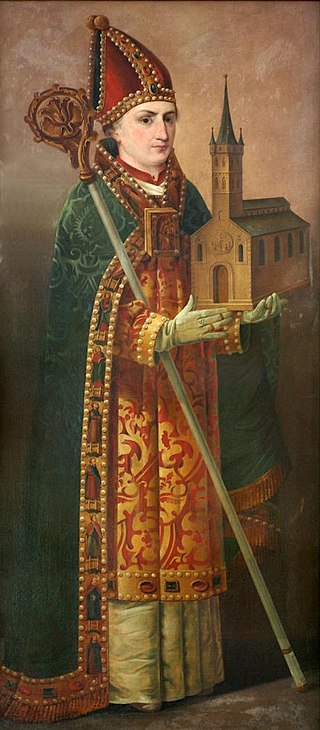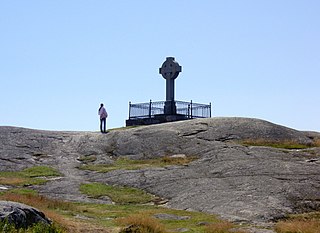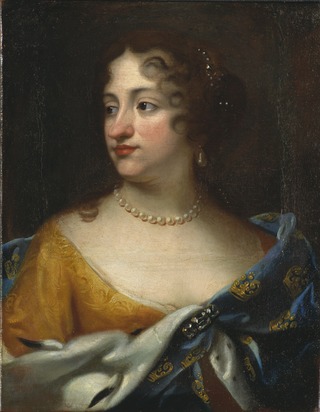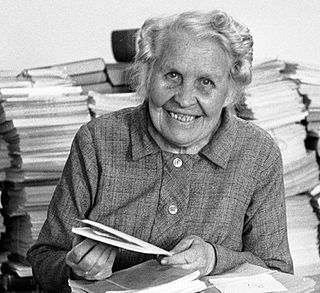
Ansgar, also known as Anskar, Saint Ansgar, Saint Anschar or Oscar, was Archbishop of Hamburg-Bremen in the northern part of the Kingdom of the East Franks. Ansgar became known as the "Apostle of the North" because of his travels and the See of Hamburg received the missionary mandate to bring Christianity to Northern Europe.

Birka, on the island of Björkö in present-day Sweden, was an important Viking Age trading center which handled goods from Scandinavia as well as many parts of Continental Europe and the Orient. Björkö is located in Lake Mälaren, 30 kilometers west of contemporary Stockholm, in the municipality of Ekerö.

Alva Myrdal was a Swedish sociologist, diplomat and politician. She was a prominent leader of the disarmament movement. She, along with Alfonso García Robles, received the Nobel Peace Prize in 1982. She married Gunnar Myrdal in 1924; he received the Nobel Memorial Prize in Economic Sciences in 1974, making them the fourth ever married couple to have won Nobel Prizes, and the first to win independent of each other.

Ekerö Municipality is a municipality in the province of Uppland in Stockholm County in east central Sweden. The name derives from the name of the main island within the municipality whose name is Ekerön, and literally means "Oak Island". Its seat is located in the town of Ekerö.
Swedish pre-history ends around 800 AD, when the Viking Age begins and written sources are available. The Viking Age lasted until the mid-11th century. Scandinavia was formally Christianized by 1100 AD. The period 1050 to 1350—when the Black Death struck Europe—is considered the Older Middle Ages. The Kalmar Union between the Scandinavian countries was established in 1397 and lasted until King Gustav Vasa ended it upon seizing power during the Swedish War of Liberation, which concluded in 1523. The period from 1350 to 1523 is considered the Younger Middle Ages. During these centuries, Sweden gradually consolidated as a single nation.

Ulrika Eleonora of Denmark was Queen of Sweden as the wife of King Charles XI. She is often admired for her generosity and charity.

The Catholic Church in Sweden is part of the worldwide Catholic Church in communion with the Pope in Rome. It was established by Archbishop Ansgar in Birka in 829, and further developed by the Christianization of Sweden in the 9th century. King Olof Skötkonung is considered the first Christian king of Sweden.
Olof was a Swedish monarch or local ruler who ruled over Birka, an important port town, and possibly Uppsala, an important early Swedish political center, in about 852, when the Catholic missionary Saint Ansgar made his second voyage from Germany to Birka in about the year 851 or 852 A.D. He had an ambivalent attitude to Christianity, and was known as a successful warrior king in the Baltic region.

The House of Munsö, also called the House of Björn Ironside, the House of Uppsala or simply the Old dynasty, is the earliest reliably attested royal dynasty of Sweden, ruling during the Viking Age. None of the names suggested for the dynasty are universally accepted and most are problematic; the name "House of Munsö" derives from a questionable and speculative theory that they would have ruled from the island of Munsö and the name "House of Björn Ironside" derives from the supposed founder of the dynasty, Björn Ironside, who is often seen as a legendary, rather than historical, figure.

Birger Magnusson was King of Sweden from 1290 to 1318. His reign was marked by unrest and civil strife; he was imprisoned by his brothers Erik and Valdemar following the "Håtuna games" in 1306, but when he tried to play them the same trick in Nyköping, there was an uprising that ended with Birger losing the crown and the execution of his 18-year-old son Magnus.

Valdemar Magnusson was a Swedish prince, heir to the throne of Sweden, and the duke of Finland.

The Diocese of Strängnäs is a part of the Lutheran Church of Sweden and has its seat in Strängnäs Cathedral in Strängnäs, south of Lake Mälaren. The diocese is made up of the two provinces Närke and Södermanland.

Caroline Frederikke Müller née Halle also known as Caroline Walther, was a Danish and later naturalized Swedish opera singer (mezzo-soprano). She was also active as an instructor at the Royal Dramatic Training Academy. She was a member of the Royal Swedish Academy of Music and a Hovsångare.

Charlotte Slottsberg was a Swedish ballerina. She was one of the first native members of the Royal Swedish Ballet. She was also known as a courtesan and as the controversial mistress of the future Charles XIII of Sweden. She was the first native star of the Royal Swedish Ballet.

Ingeborg Åkesdotter Tott, in her lifetime called Ingeborg Åkesdotter or simply Fru Ingeborg, was a Swedish noble and the consort of the Swedish regent Sten Sture the Elder. She was the fiefholder of Häme in Finland. She functioned as the de facto queen consort of Sweden for over three decades and participated in state affairs during the reign of her spouse.
Görwel Christina Carlsdotter Gyllenstierna (1646-1708) was a Swedish noblewoman duellist and landowner.

Vivi Laurent-Täckholm was a Swedish botanist and children's book writer, active in Egypt.
Björn was a Swedish monarch or local ruler who ruled over Birka, an important port town, and possibly Uppsala, an important early Swedish political center, around the year 829. His existence is attested by the nearly contemporary account Vita Ansgari, written by the missionary Rimbert, who visited Sweden alongside Ansgar in c. 852. He is in fact the first Swedish figure referred as king who is known from a reasonably reliable source. Older Swedish historiography often identified the king with the legendary figure Björn at Haugi, who was supposedly a Swedish ruler in the generation before the youth of Harald Finehair of Norway. This identification is however considered unverifiable, since Björn at Haugi may have actually been a Norwegian local ruler who was later constructed as a Swedish king. Although the genealogy of early Swedish local rulers is not known, Björn is assumed to have belonged to the House of Munsö, which would later produce Eric the Victorious, generally considered to be Sweden's first king. The royal names attested in the ninth century, namely, also occur among the kings and princes in the late Viking age, perhaps suggesting a genealogical continuity.
Eric was a Swedish monarch or local ruler who ruled over Birka, an important port town, and possibly Uppsala, an important early Swedish political center, and is mentioned as dead by 852. His existence is attested by the nearly contemporary account Vita Ansgari, written by the missionary Rimbert, who visited Sweden alongside Ansgar in c. 852. By the time of their visit, a king by the name Olof ruled, with Eric being deceased since a while.
Oloph Eric Fingal Bexell is a Swedish priest and professor emeritus in church history at Uppsala University.













